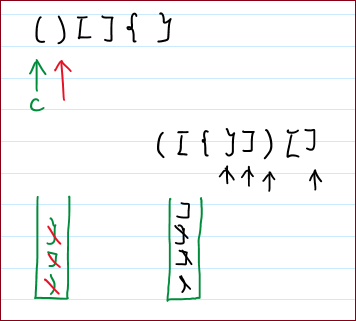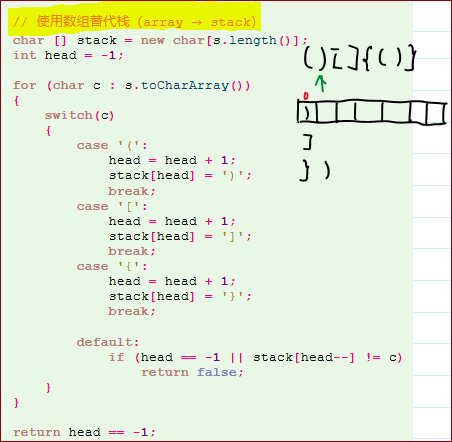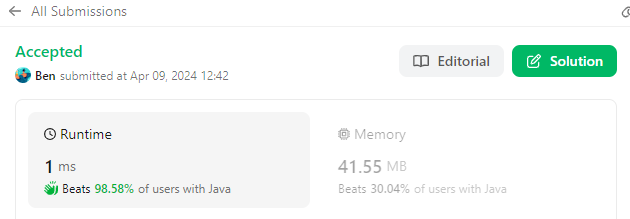[Coding041] LeetCode 20
Valid Parentheses
Get the knowledge flowing and circulating! :)
目录
※ 本题收获
switch的用法;
对于栈的操作,如果想要出栈,则需要先判断栈是否为空。如果栈是空的,则
stack.pop(); stack.peek();都是会报错的。
心得:一开始在看这道题的时候,时隔很久了。突然间竟然没了思路。后来慢慢调试,写出了代码1.
就代码2~4而言,都是之前自己写过的,却未曾想到现在竟然都不记得了!
所以说啊,编程这东西,同一道题(哪怕像本题是easy),依然值得反复再看、再编,直到把思路融汇贯通。
看着自己的代码1,显得十分生涩。但是最终调试成功,也是值得开心的。
本题收获还是比较大的。比如这个用栈来实现括号匹配的思路:
★ 普通思路:
首先对于左一半,都要入栈;
对于由一半,都要比较:如果和上一个入栈的匹配了,例如上一个入栈的是
{,而当前是},则证明可以把上一个刚刚入栈的{给弹出来,继而继续处理下一个字符;要知道,不管怎样入栈和出栈,都会遇到这样的情况:({[]})
[]or ([{}]),即,总有两个字符刚好是左右匹配的括号;这样的话,就可以遇到匹配的,就弹出,最后留下空栈。
★ 好思路:
看到左括号
({[,则对应入栈右括号)}];如果看到了右括号,则出栈,看看是否当前处理的字符和栈顶是
一样的不一样,则一定是false了;
题目:20. Valid Parentheses
Given a string s containing just the characters '(', ')', '{', '}', '[' and ']', determine if the input string is valid.
An input string is valid if:
Open brackets must be closed by the same type of brackets.
Open brackets must be closed in the correct order.
Every close bracket has a corresponding open bracket of the same type.
Example 1:
xxxxxxxxxx21Input: s = "()"2Output: true
Example 2:
xxxxxxxxxx21Input: s = "()[]{}"2Output: true
Example 3:
xxxxxxxxxx21Input: s = "(]"2Output: false
Constraints:
1 <= s.length <= 104sconsists of parentheses only'()[]{}'.
代码1(配 · 手绘过程图)
xxxxxxxxxx531class Solution {2 public boolean isValid(String s) {3 char[] cs = s.toCharArray();4 Stack<Character> stack = new Stack();5 for (char c : cs)6 {7 switch(c)8 {9 case '(':10 stack.push(c);11 break;12 case '[':13 stack.push(c);14 break;15 case '{':16 stack.push(c);17 break;18 19 case ')':20 {21 if (!stack.empty() && stack.peek() == '(')22 stack.pop();23 else24 return false;25 }26 break;27 case ']':28 {29 if (!stack.empty() && stack.peek() == '[')30 stack.pop();31 else32 return false;33 }34 break;35 case '}':36 {37 if (!stack.empty() && stack.peek() == '{' )38 stack.pop();39 else40 return false;41 }42 break;43
44 }45 46 }47
48 if (stack.empty())49 return true;50 else51 return false;52 }53}复杂度分析
代码2
xxxxxxxxxx231class Solution {2 public boolean isValid(String s) {3 4 Stack<Character> stack = new Stack<>();5 6 stack.push('#');7 for (int i = 0; i < s.length(); i++)8 {9 char c = s.charAt(i);10 11 if (c == ')' && !stack.empty() && stack.peek() == '(')12 stack.pop();13 else if (c == ']' && !stack.empty() && stack.peek() == '[')14 stack.pop();15 else if (c == '}' && !stack.empty() && stack.peek() == '{')16 stack.pop();17 else18 stack.push(c);19 }20 21 return stack.peek() == '#'; // 省了判空的步骤了~ 巧妙。22 }23}代码3(配 · 手绘过程图)
xxxxxxxxxx211class Solution {2 public boolean isValid(String s) {3 4 Stack<Character> stack = new Stack<>();5 6 for (char c : s.toCharArray())7 {8 if (c == '(')9 stack.push(')');10 else if (c == '[')11 stack.push(']');12 else if (c == '{')13 stack.push('}');14 else if (stack.empty() || stack.pop() != c)15 return false;16 17 }18 19 return stack.empty();20 }21}
代码4(配 · 手绘过程图)
思路:使用数组来代替栈!
xxxxxxxxxx321class Solution {2 public boolean isValid(String s) { 3 // 使用数组替代栈(array → stack)4 char [] stack = new char[s.length()];5 int head = -1;6 7 for (char c : s.toCharArray())8 {9 switch(c)10 {11 case '(': 12 head = head + 1;13 stack[head] = ')';14 break;15 case '[':16 head = head + 1;17 stack[head] = ']';18 break;19 case '{':20 head = head + 1;21 stack[head] = '}';22 break;23 24 default:25 if (head == -1 || stack[head--] != c)26 return false;27 }28 }29 30 return head == -1;31 }32}
测试样例
"(]"false
"(])"false
"()[]{}"true
"([])[]{}"true
"]"false
"({})[(])"false
★ 知识点积累 (Java)
switch-case使用方法
case后面跟的是判断表达式;
每个case体里要有break,否则会顺序往下执行;
case执行完后,会执行switch体外的语句。
xxxxxxxxxx291public class xxx {2
3 public static void main(String[] args) {4 // TODO Auto-generated method stub5
6 int option = 2;7
8 switch (option) 9 {10
11 case 1:12 System.out.println("选择了选项 1");13 break;14
15 case 2:16 System.out.println("选择了选项 2");17 break;18
19 case 3:20 System.out.println("选择了选项 3");21 break;22
23 default:24 System.out.println("无效选项");25 break;26
27 }28 }29}运行结果:
xxxxxxxxxx291public class xxx {2
3 public static void main(String[] args) {4 // TODO Auto-generated method stub5
6 int option = 2;7
8 switch (option) 9 {10 case 1:11 System.out.println("选择了选项 1");12 break;13 14 case 2:15 System.out.println("选择了选项 2");16 // break;17 18 case 3:19 System.out.println("选择了选项 3");20 break;21 22 default:23 System.out.println("无效选项");24 break;25 }26 27 System.out.println("Outside Switch!");28 }29}运行结果:
xxxxxxxxxx291public class xxx {2
3 public static void main(String[] args) {4 // TODO Auto-generated method stub5
6 int option = 100;7
8 switch (option) 9 {10 case 1:11 System.out.println("选择了选项 1");12 break;13 14 case 2:15 System.out.println("选择了选项 2");16 // break;17 18 case 3:19 System.out.println("选择了选项 3");20 break;21 22 default:23 System.out.println("无效选项");24 break;25 }26 27 System.out.println("Outside Switch!");28 }29}运行结果:



